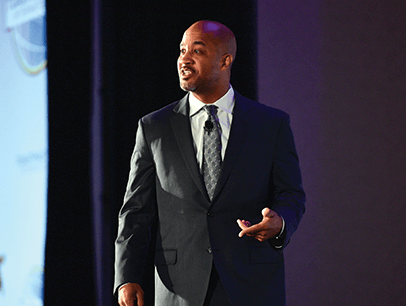
Humans have a vast and rich relationship with storytelling—from cave paintings, written words, and oral traditions to PowerPoint presentations and TED Talks. And though the medium continues to evolve, the want for storytelling is inherently the same—intrinsically human.
The presenter in you has likely wondered, what makes a “good” story? After more than 20 years in the vocal coaching industry, I have seen firsthand what takes a story from forgettable to memorable—vulnerability.
What Is Vulnerability?
Vulnerability is a key foundation of voice. This concept is perhaps most obvious in singing. To fully express a song, we need to tap into our emotions and really feel the story to effectively express the story. Same goes for acting, and you guessed it, for public speaking and day-to-day conversations. Emotions build story and vulnerability is the gateway. Vulnerability is the “how” behind emotional connection, and it endears an audience to a storyteller. But vulnerability also comes with a flip side.
In her 2010 TEDx Talk, “The Power of Vulnerability,” researcher and author Brené Brown, Ph.D., defined vulnerability as “uncertainty, risk, and emotional exposure.” For most people, this is not an ideal concoction. But to make your mark, you must be willing to get a bit uncomfortable. You must be willing to risk being seen as too much or not enough; too “this way” and not enough “that way.” It’s in this risk that the connection to your audience is born. (And likely, your audience is not thinking any of those things about you anyway.)
As Brown shares, “The difficult thing is that vulnerability is the first thing I look for in you and the last thing I’m willing to show you. In you, it’s courage and daring. In me, it’s weakness.”
The Best Stories Are Emotional
From a neurological standpoint, human beings are wired to share things that move us emotionally. We are also wired to remember them, whether it’s something that made us happy, sad, angry, etc. If we’re moved, chances are we’ll remember it.
Still, there’s no denying that some presenters shine while others flicker. So, what exactly differentiates the wow from the underwhelming? The answer largely comes down to how the presenter made us feel. This is vulnerability in action.
Being vulnerable will help invoke emotion in your audience, and how you genuinely make someone feel is what takes your story to the next level.
The Brain on Storytelling
The brain has a fascinating relationship with storytelling. In fact, stories create meaningful connections between concepts and words—this assists in how we remember things.
As explained in molecular biologist John Medina’s book Brain Rules, “When the brain detects an emotionally charged event, the amygdala releases dopamine into the system … dopamine greatly aids memory and information processing.” Stories have power, and they can be enhanced through vulnerability, as a means of creating emotional connection and stronger recall in an audience.
Perks of Vulnerability
Vulnerability is the gateway to emotions, and emotions are the gateway to memorable stories. A few of the many perks of incorporating vulnerability into your next presentation include:
- Creating a human connection
- Encouraging sharing about difficult subjects
- Promoting transparency and reciprocity
- Garnering trust
- Building rapport
- Allowing for next-level performances
How to Access Vulnerability
So often as presenters, we take careful consideration to craft the perfect story—the perfect words, concepts, imagery, and delivery. And those are all marvelous if you start with an emotional connection as your foundation.
Ask yourself, Why am I telling this particular story? What does it mean to me? How does it make me feel? Recounting events is not telling stories; moving someone emotionally is.
You don’t have to share everything to effectively tell a story, but sharing some personal details will make the story more endearing.
Here are some ways to access and practice vulnerability:
Create a safe space.
If you’re new to this practice, you’ll want to create a sense of safety as you explore your emotional side. Find a private quiet space, throw on your coziest sweater, brew a cup of tea, whatever makes you feel your best. Next, explore the emotional aspects of your story and let that emotion guide the story as if you were telling it to your best friend. How might this change your delivery? Record it and listen back later so you’re not tempted to judge the process as it happens.Repetition.
Vulnerability is akin to a muscle that needs strengthening. Just as you get more comfortable with lifting a weight as you increase the repetitions or weight itself, you are more willing to embrace vulnerability with practice. It will feel less uncomfortable the more you do it.Ditch perfectionism.
To be human is to be imperfect. And we want to harness this imperfection because it’s relatable! Vocal coach Kimberley Smith is a big proponent of imperfection as a means to access vulnerability, and ultimately, next-level performances. “When it’s perfect, it’s boring, and [we, the audience] don’t feel anything,” she says. “Stay in the felt emotion in your body and then let whatever comes out come out—and it does feel incredibly vulnerable.”Vulnerability is the “how” behind emotional connection, and it endears an audience to a storyteller.
Stay in the story.
Exercise mindfulness. When you’re speaking, ditch the outward focus (i.e., what are people thinking of me?) for an inward focus (i.e., what’s the story, and how does it make me feel?). The key is to stay in the story and resist the urge to judge your experience of the storytelling. Sure, you’ll flip-flop, but the trick is to speed up the comeback. It might be helpful to set an intention for your story—what are you trying to share? Use this to bring you back to the story.Play or laugh.
Broadway musical theater coach Mary Saunders Barton recommends play as the vehicle to vulnerability. “Play is the center of everything. Laughing helps engage in the connection to the body, and it helps you let go of a lot of other things. And it’s an ultimate relaxer.”Embrace the “yuck,” the challenges.
You cannot build trust with your listener if you only talk about successes. Challenges make for great stories; they are relatable and they amp up the tension. As Brown says, “Vulnerability requires courage, repetition, and the ability to manage one’s own discomfort.”You don’t need to tie your story with a bow.
It’s okay not to have an ending; you might still be trying to process your story’s experience. Be honest—if you’re still learning and growing, let your listener know. Uncertainty is a form of vulnerability.Do a trial run.
Practice storytelling with someone who makes you feel safe. Then try it again with a group that makes you feel a little nervous. (It’s easier to tap into those emotions when the nervous system feels safe.)Explore your voice.
When practicing vulnerability in storytelling, you may be surprised at some of the sounds you make. Get curious! Explore how to best use your instrument for emotional delivery and convey what you mean.Honor your growth.
Celebrate your successes! And remember to reserve judgment. This practice takes courage.Put vulnerability in action. Remember practice—not perfection—while feeling your way to greatness. And when the road gets tough, remember being vulnerable will help invoke emotion in your audience, and therefore, connection and memorability.
Watch 1999 World Champion of Public Speaking Craig Valentine as he shares the top tools you need to build a message that sticks.
Jillian Mitchell is a vocal coach, recording artist, podcast host, writer, and all-around voice advocate. She is the founder of Voxsana, an online platform dedicated to voice empowerment, and most recently has joined the 2024 TEDxRRU speaker coach team in her hometown. Jillian lives in Victoria, British Columbia, Canada, with her husband and two children.
Related Articles

Presentation Skills
Everyone Has a Story

Communication



 Previous
Previous

 Previous Article
Previous Article